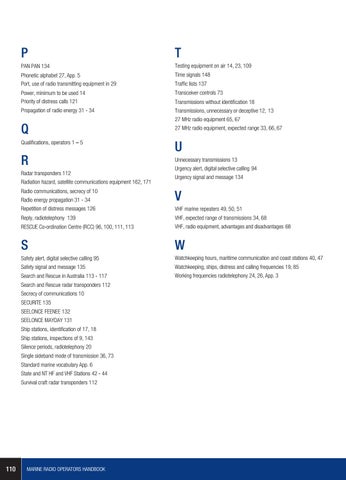p
t
PAN PAN 134
Testing equipment on air 14, 23, 109
Phonetic alphabet 27, App. 5 Port, use of radio transmitting equipment in 29
Time signals 148
Power, minimum to be used 14 Priority of distress calls 121
Transceiver controls 73
Propagation of radio energy 31 - 34
Transmissions, unnecessary or deceptive 12, 13 27 MHz radio equipment 65, 67
q Qualifications, operators 1 – 5
r Radar transponders 112 Radiation hazard, satellite communications equipment 162, 171 Radio communications, secrecy of 10 Radio energy propagation 31 - 34 Repetition of distress messages 126
Transmissions without identification 18
27 MHz radio equipment, expected range 33, 66, 67
u Unnecessary transmissions 13 Urgency alert, digital selective calling 94 Urgency signal and message 134
v VHF marine repeaters 49, 50, 51
Reply, radiotelephony 139
VHF, expected range of transmissions 34, 68
ReSCUe Co-ordination Centre (RCC) 96, 100, 111, 113
VHF, radio equipment, advantages and disadvantages 68
s
w
Safety alert, digital selective calling 95
Watchkeeping hours, maritime communication and coast stations 40, 47
Safety signal and message 135
Watchkeeping, ships, distress and calling frequencies 19, 85
Search and Rescue in Australia 113 - 117
Working frequencies radiotelephony 24, 26, App. 3
Search and Rescue radar transponders 112 Secrecy of communications 10 SECURITE 135 SEELONCE FEENEE 132 SEELONCE MAYDAY 131 Ship stations, identiďŹ cation of 17, 18 Ship stations, inspections of 9, 143 Silence periods, radiotelephony 20 Single sideband mode of transmission 36, 73 Standard marine vocabulary App. 6 State and NT HF and VHF Stations 42 - 44 Survival craft radar transponders 112
110
Traffic lists 137
MARINE RADIO OPERATORS HANDBOOK
